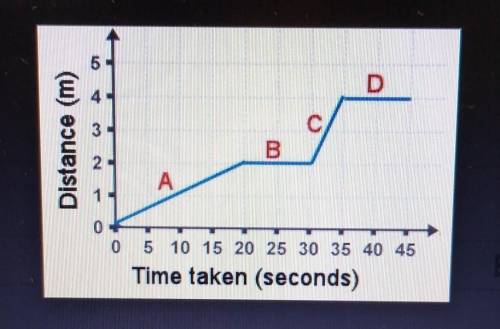What is the motion of the object in section B of the graph? Explain
...

Physics, 17.11.2020 21:50 reyescarlosivan0
What is the motion of the object in section B of the graph? Explain


Answers: 1
Another question on Physics

Physics, 21.06.2019 21:00
In order to place a satellite into orbit, it requires enough fuel to supply the necessary mechanical energy. into what types of mechanical energy does the fuel get transformed?
Answers: 1

Physics, 21.06.2019 22:00
1. consider the case in which air fills air shocks on a truck trailer. the pressure in the shocks is 2 mpa. the temperature is 300 k. the diameter of the shock piston is 10 cm and the initial length of the cylindrical cavity containing the compressed air is 40 cm. a. the truck is gradually loaded over a period of a day in a static setting. the temperature is held constant for the atmosphere and thus for the gas shock. calculate the compressibility of the air in the shock for this condition when the truck is initially being loaded. b. if the shocks were loaded in a dynamic setting by driving over bumps, what would be the compressibility? state your assumption. c. what is the initial load on the shock if the shock is in an atmospheric 100 kpa? d. if the shock is compressed using the process described in part a, and the air shock compressed air cavity length decreases to 20 cm, what is the additional load applied to the shock?
Answers: 2

Physics, 22.06.2019 17:00
In the future, people will only enjoy one sport: electrodisc. in this sport, you gain points when you cause metallic discs hovering on a field to exchange charge. you are an electrodisc player playing the popular four disc variant. the disks have charges of qa = −8.0 µc, qb = −2.0 µc, qc = +5.0 µc, and qd = +12.0 µc. (1) you bring two disks together and then separate them. you measure the resulting charge of these two disks and find that it is +5.0 µc per disk. which two disks did you bring together? (a) a and b (b) a and c (c)a and d (d)b and c(e) b and d (f) c and d. (2) you bring three disks together and then separate them. you measure the resulting charge of these three disks and find that it is +3.0 µc per disk. which three disks did you bring together? a, b, and c (a) a, b, and d (c) a, c, and d (d) b, c, and d. (3) given the resulting charge of each disk measured in (b) is +3.0 µc, how many electrons would you need to add to a disk of this charge to electrically neutralize it? electrons
Answers: 3

Physics, 22.06.2019 23:30
When barack obama was running for president, at a campaign stop he tried to bowl, something he isn't very good at. the media loved it because he threw a gutter ball while they were all watching. this is an example of:
Answers: 2
You know the right answer?
Questions


Physics, 03.12.2021 23:50


Mathematics, 03.12.2021 23:50

Mathematics, 03.12.2021 23:50

Biology, 03.12.2021 23:50




Mathematics, 03.12.2021 23:50


Mathematics, 03.12.2021 23:50



Computers and Technology, 03.12.2021 23:50


Mathematics, 03.12.2021 23:50

Computers and Technology, 03.12.2021 23:50




